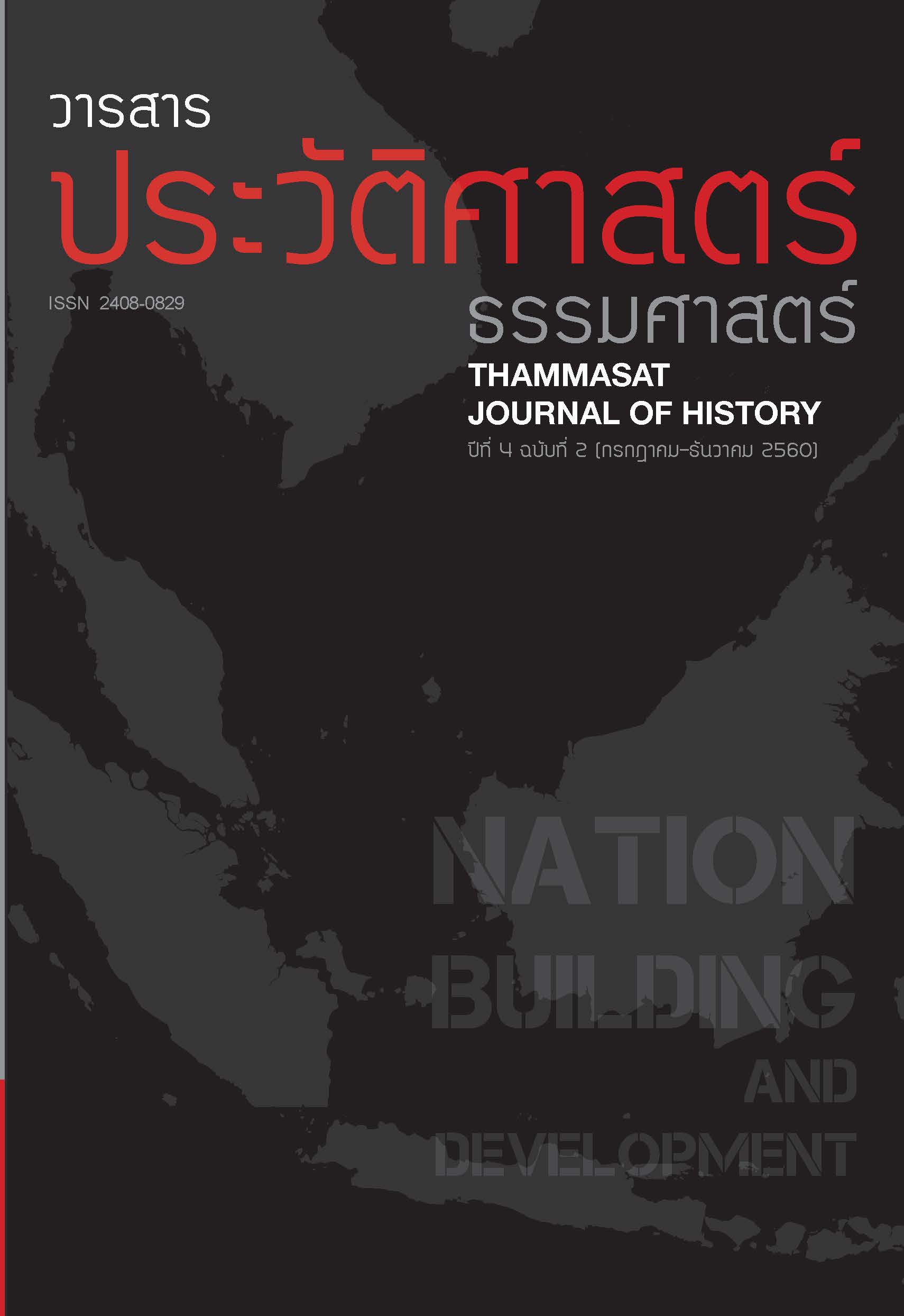ผู้หญิงกับประวัติศาสตร์การสวมหมวกความขัดแย้งทางวัฒธรรมการสวมหมวกระหว่างผู้หญิงสยาม ในสมัยสมบูรณาญาสิทธิราชย์และหลังการเปลี่ยนแปลงการปกครอง
Main Article Content
บทคัดย่อ
บทความวิชาการนี้ศึกษาบทบาทของการสวมหมวกที่มีต่อทัศนคติในการแสดงออกผ่านร่างกาย (bodily representation) ของผู้หญิงชั้นสูงของสยาม ซึ่งแบ่งออกเป็นสองยุค ได้แก่ ยุครุ่งเรืองของระบอบสมบูรณาญาสิทธิราชย์ (2411-2475) และ ยุคหลังการเปลี่ยนแปลงระบอบการปกครองภายใต้รัฐนิยม (2482-2488) ในขณะที่หมวกกะโล่เป็นที่นิยมในชนชั้นแรงงานของยุควิคตอเรียนในเกาะอังกฤษ แต่สำหรับผู้ชายชั้นสูงสมัยรัชกาลที่ ๕ นั้น หมวกกะโล่ถือเป็นเครื่องหมายของความซิวิไล (civilised) ซึ่งแฝงอยู่กับกลิ่นอายของอิทธิพลตะวันตก ที่คืบคลานเข้ามาในสยามเวลานั้น เช่นกันสำหรับสตรีชั้นสูงของสยาม ผู้หญิงฝ่ายในตอบรับต่อกระแสการสวมหมวกเป็นอย่างดี พร้อมทั้งเล็งเห็นว่าการสวมหมวกเป็นการยกระดับการแต่งกายเพื่อให้สอดคล้องกับสมัยนิยม อย่างไรก็ตาม ภายหลังการเปลี่ยนแปลงระบอบการปกครอง รัฐบาลภายใต้การนำของ จอมพลแปลก พิบูลสงครามได้นำการสวมหมวกมาส่งเสริมอีกครั้ง แต่กลับถูกต่อต้านจากกลุ่มสตรีจากหลากหลายชนชั้น รวมทั้งกลุ่มผู้ดีเก่าที่เคยนิยมการสวมหมวกมาก่อน บทความนี้จึงต้องการที่จะเปรียบเทียบทัศนคติที่มีต่อการสวมหมวกในสองยุคสมัย โดยผ่านการวิเคราะห์ เอกสารทางราชการ เอกสารชั้นต้น และ แหล่งข้อมูลทุติยภูมิ เพื่อที่จะตีแผ่ถึงความหมายทางการเมืองที่มีต่อการสวมหมวกตามสมัยนิยม ในช่วงเปลี่ยนแปลงทางสังคมและวัฒนธรรมของสยาม
Article Details
ลิขสิทธิ์บทความเป็นของผู้เขียนและสงวนสิทธิ์ตามกฎหมาย
ข้อคิดเห็นใดๆ ที่ปรากฏในวารสารนี้เป็นของผู้เขียน คณะกรรมการวารสาร ภาควิชาประวัติศาสตร์ฯ กองบรรณาธิการ ตลอดจนกรรมการกลั่นกรองประจำฉบับ ไม่จำเป็นต้องเห็นพ้องกับข้อคิดเห็นเหล่านั้น
References
Ministry of Education (so. tho.) Cultural Mandates (ratthaniyom) (Bangkok: National Archives of Thailand).
Ministry of Education (so. tho.) 15.2.1/13 women’s dress code (Kan-taengkai khong satri-thai).
Ministry of Education (so. tho.) 15.2.1/20 The importance of the support of national culture (Khwamsamkhan nai kanbamrungwatthanatham khong chat).
Barmé, Scot. Woman, Man, Bangkok: Love, Sex, and Popular Culture in Thailand. Oxford: Rowman & Littlefield, 2002.
Kobkua Suwannathat-pian. Thailand’s Durable Premier: Phibun through Three Decades 1932-1957. Kuala Lumpur: Oxford University Press, 1995.
Krom Sinlapakon. Notables Women in Thai History (Satri-Samkhan Nai Prawatisat Thai). Bangkok: Krom Sinlapakon, 2004.
Orasom Sutthisakhon. Flowers of the Nation (Dokmai khong chat: chakwethu khwam ngam su wethi chiwit album chiwit 13 nangsao thai yuk raek. Bangkok: Ruamtat Press, 1990.
Peleggi, Maurizio. Lords of Things: the Fashioning of the Siamese Monarchy’s Modern Image. Honolulu: University of Hawaii Press, 2002.
Ratchabandittayasathan. Thai-Thai Dictionary (Photchananukrom Chabab-ratchabandittayasathan). Bangkok: Ratchabandittayasathan, 1999.
Thongchai Winichakul. Siam Mapped: A History of the Geo-body of a Nation. Honolulu: University of Hawaii Press, 1994.
Wannaphon Boonyasatit. Powerful Women of Siam: Rama 4 – Rama 6 Reigns and the Wave of Western Cultural Influence (chomnang haeng siam nai samai ratchakan thi 4 thueng ratchakan thi 6 kab krasae watthanatham tawantok). Bangkok: Sangsan Books, 2009.
Thongchai Winichakul. “The Quest for ‘Siwilai’: A Geographical Discourse of Civilizational Thinking in the Late Nineteenth and Early Twentieth-Century Siam.” The Journal of Asian Studies (2000): 59 (3), 528-549.
Baan Suntaraporn. “Suam Muak”: http://www.websuntaraporn.com/suntaraporn/lyric/postlyric.asp?GID=298 (accessed February 20, 2017).
Kaewmala. “Thongchai: Thai-style history education makes Thais ignorant and narcissistic”: https://prachatai.com/english/node/3649 (July 22, 2013) (accessed May 4, 2017).
Krobkrua Khunyai Vani. “mua pen nagsao sayam”: http://khunyaivanee.com/pro_galleries/show/003 (2015) (accessed February 20, 2017).
National Scout Organization of Thailand “In the reign of King Rama VI” (nai samai ratchakan thi hok). Retrieved from http://www.thaiscouting.com/history-of-scouting-in-thailand/http://www.scoutthailand.org/index.php?option=com_content&view=article&id=51&Itemid=7 (2013) (accessed October 7, 2013).
Pairaya Ponsaratoon, “Thai Women’s Beauty Myth 1938-1973.” (maya khathi khwanngam khong sattri thai 2481-2516), (Thesis). Bangkok: Chulalongkorn University, 2006.
Sujira Aroonpipat. “The Political Economy of the Beauty Contest: Case study of Miss Thailand Contest.” (setthasat kanmueang wa douay kan phalit nang ngam:korani seuksa kan prakuad nang sao thai), (Thesis), Bangkok: Chulalongkorn University, 2007.
Suwadee Tanaprasitpatana. “Thai society’s expectations of women, 1851-1935.” (Unpublished Ph.D. dissertation), University of Sydney, Australia, 1989.

